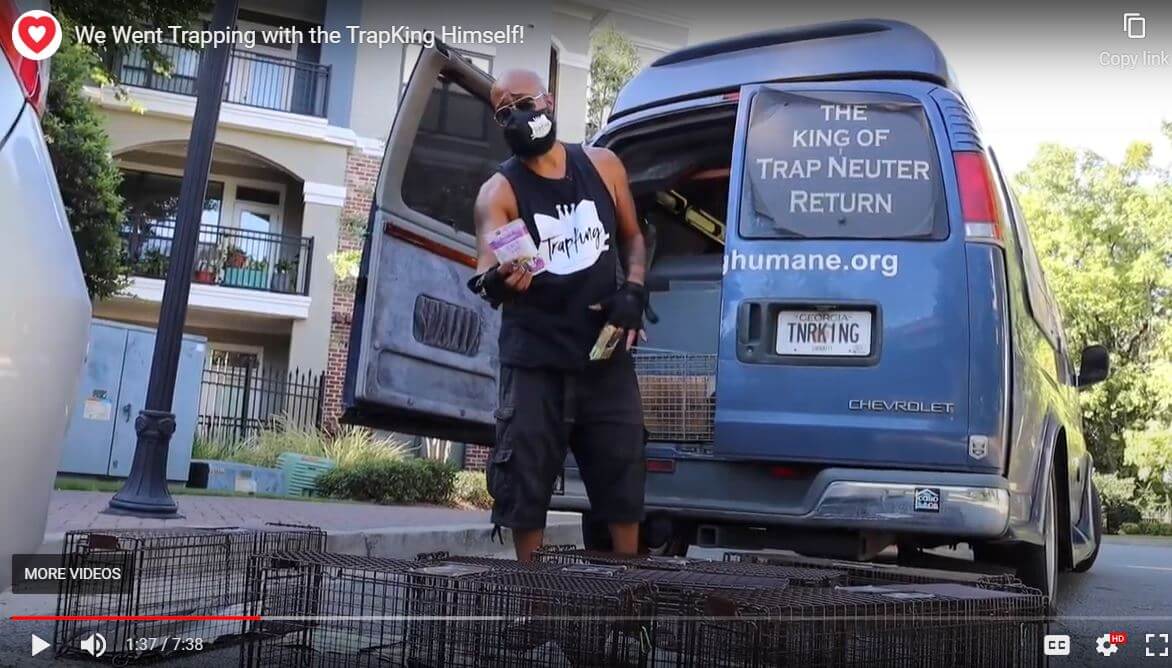Humane Trapping Techniques
While trapping can sound intimidating, when done correctly, it is the most humane and effective strategy for controlling free-roaming, or community, cat populations. Humane trapping also improves the quality of life for these cats. Cats who go through a TNR program are less stressed, healthier, and coexist more peacefully with humans and one another.
Trapping community cats can be a fine art but with the right information and technique, you can become a successful trapper!

Trapping a Community Cat
- Use the proper equipment. Only use humane box traps to safely trap cats. Never use nets, darts, or tranquilizer guns as these are dangerous and stressful to cats. You can purchase a humane cat trap online.
- Don’t handle a community cat. For your and the cats’ safety, never directly pick up a feral cat no matter how friendly they seem.
- Target a specific area. Start your trapping in a specific area with cats or by targeting a specific colony. Set multiple traps in this area and count the traps so you know how many have been set.
- Schedule a spay or neuter appointment. Ideally, cats should be trapped the day before the surgery date as cats should not be left in a trap for more than 48 hours.
- A trapped cat is not necessarily a happy cat. Many cats don’t like being in traps. Once a cat is trapped, it’s likely that they’ll thrash. You can help calm the cat down by covering the entire trap with a towel or blanket. This will help them feel more safe and secure.
Setting up a Trap
If you’re caring for the cat community already, it’s recommended that you withhold food from cats for 24 hours before trapping while continuing to provide water. This helps encourage the cats towards the food in your traps on trapping day. If you’re helping to trap a colony where there are other caregivers, be sure to let them know to withhold food because you will be trapping.
- Line the bottom of the trap with newspaper or cardboard so that the floor is more comfortable for their paws.
- Tag the trap. Put a tag on the trap with the address or street name of where that community cat was found. This will help when returning the cat to their original location.
- Bait the traps; the smellier, the better! Place about one tablespoon of bait in a container that you can then use later to fill with water while the cat is awaiting surgery. Tuna in oil, sardines, or other strong-smelling food works the best. Place this food at the very back of the trap and lightly drizzle some bait juice along the trap door toward the entrance. The cat will be enticed by the smell of the bait juice and step on the trigger plate while attempting to reach the food in the back of the trap.
- Placing traps. For the safety of the cats, always place traps on flat and stable ground. If you’re using multiple traps, stagger them and face them in different directions. Try to place the traps in quiet and hidden areas so that cats are more comfortable going near them.
- Monitor and keep track of traps. Traps should never be left unattended in the event of malfunction or injury. Check the traps frequently but from a distance so you don’t scare cats away. This will require patience, so don’t feel like you need to rush this step of trapping! If some other wild animal or an unintended cat is captured, release the animal in a quiet area within sight of where it was trapped.
- Cover the trap as soon as a cat is caught. Uncovered, the cat may panic and injure itself by thrashing. A blanket or towel will work great to cover the trap.
- Check your trapped cat’s ears. If one of the ears is tipped, the cat has already been spay/neutered and should be released.
- Check for kittens. If you suspect you have trapped a nursing female, check the area for kittens. If kittens are found, release the cat. Do not attempt to handle or take the kittens. Click here for more information on what to do if you find kittens.
- Schedule a spay or neuter appointment. Ideally, cats should be trapped the day before the surgery date as cats should not be left in a trap for more than 48 hours.
- Caught a community cat? Once the cat is in the trap, please refer to How to Care for your Cat between the time of trapping and surgery day.
Important: Know when your veterinarian or spay/neuter clinic is able to accommodate your cat. Ideally, cats should be trapped the day before the surgery date. Cats should not be left in a trap for over 48 hours. If your appointment is outside of 48 hours, please release the cat and re-trap at least 24 hours before your appointment.
Releasing Your Community Cat
When it is time to release your cat, it’s important to release them back where you originally trapped them. After surgery, do not relocate your community cats. Cats are territorial and form strong bonds with their outdoor homes. Relocation is extremely stressful and can be risky for both the cat and you. If the environment where the cat was trapped is unsafe, relocate them only as the absolute last resort.
- Keep the trap covered to help minimize the cat’s stress.
- Make sure the spot where you are releasing the cat is away from any immediate danger, such as a busy road.
- Releasing the cat near a bush is a good option because they will see the bush as a safe place to hide and it will entice them to leave the trap.
- When you are ready, place the trap down with the door facing away from you. Then, remove the cover and open the trap’s door. The cat will most likely bolt immediately out of the trap. If they do not, gently tilt the back of the trap slightly upwards and tap the trap to encourage the cat to leave. Do not put your hand in the trap.
Additional Resources for Trapping Tips:
This video from Kitten Lady shows step by step how to trap a feral cat: https://www.youtube.com/watch?v=wF_omFE7Etc
This webinar by The Community Cats Podcast discusses tips and tricks for humanely trapping community cats: https://www.communitycatspodcast.com/webinar-recordings/
